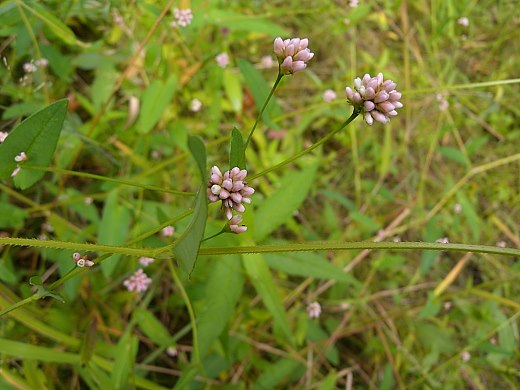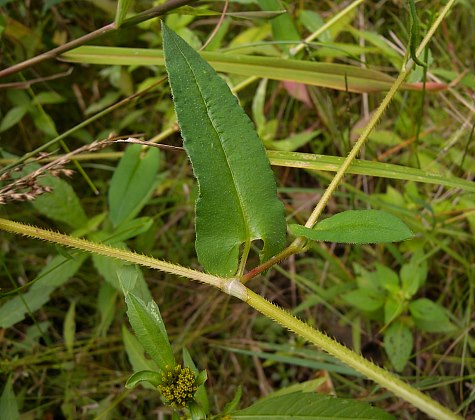Description: This herbaceous plant is an annual vine about 3-6' long that branches occasionally. It often climbs over adjacent vegetation (or itself), creating a tangle of stems and leaves. The stems are light green, yellowish green, or red; they are strongly angular and prickly. The well-developed prickles are curved with their tips pointing downward. Alternate leaves are widely spaced along the stems. The leaf blades are up to 4" long and 1" across; they are narrowly sagittate to sagittate in shape and their margins are smooth and slightly ciliate with stiff hairs. The upper blade surfaces are medium green and hairless, while their lower surfaces are pale green and slightly prickly along their central veins.

The leaves are sessile or they have petioles up to 1"
long. Near the base of each petiole, there is an oblique membranous
sheath (ochrea) that wraps around the stem; this sheath is largely
devoid of hairs and prickles. Both terminal and
axillary flowers are produced on short spike-like racemes. The racemes
are globoid or ovoid-globoid in shape and up to ½" long; they are
produced individually or in pairs on long naked peduncles up to 6"
long. The flowers are densely arranged along each raceme. Individual
flowers are about 1/8" (3 mm.) long, consisting of 5 white to pink
tepals, 8
short stamens, and an ovary with a tripartite style. At the base of
each raceme, there is a pair of small green bracts. Similarly, at the
base of each flower, there is a pair of tiny
bracts that are greenish
yellow and ovate. The blooming period occurs from mid-summer into the
fall and lasts about 2-3 months. Each flower is replaced by a single
dark seed that is about 3 mm. long, ovoid, and bluntly 3-angled. This
herbaceous vine can form rootlets where the stems are decumbent on
moist open ground.
Cultivation:
The preference is partial sun, wet to moist conditions, and soil
containing silty loam, sand, gravel, or peat moss. Most growth and
development occurs during the summer. Temporary flooding is tolerated.
Range & Habitat:
Arrow-Leaved Tearthumb is occasional throughout Illinois, where it is
native. In addition
to its distribution in eastern North America, this herbaceous vine also
occurs in China. It is found in a variety of wetland habitats,
including marshes, swamps, recently burned bogs, gravelly seeps, low
areas along springs, and soggy thickets. The marshes, swamps, and soggy
thickets where this vine occurs are sometimes sandy and sometimes
non-sandy.
Faunal Associations:
The floral-faunal relationships of Arrow-Leaved Tearthumb are similar
to Persicaria spp. (Smartweeds). The nectar and
pollen of the flowers attract primarily small bees, wasps, and flies.
The leaves are eaten by the caterpillars of the butterflies Lycaena
helloides (Purplish Copper) and Lycaena hyllus
(Bronze Copper), while the flowers and developing seeds are eaten by
the caterpillars of the butterfly Strymon melinus
(Gray Hairstreak). Other insects that feed on this plant include flea
beetles, aphids, stinkbugs, and the caterpillars of several moths.
Various species of birds that occur in wetlands eat the seeds; these
include Mallards and other dappling ducks, some rails, and granivorous
songbirds (e.g., Bobolink, Swamp Sparrow, Redwing Blackbird). Because
it often forms dense tangles of prickly stems and leaves, Tearthumb
provides protective cover for various kinds of wildlife.
Photographic Location:
A soggy sandy thicket at the Iroquois County Conservation Area in
Illinois.

Comments: Arrow-Leaved Tearthumb is very similar to the more common Persicaria spp. (Smartweeds), except it is a sprawling vine rather than an erect plant. Because of its prickly stems, arrowhead-shaped leaves, and short dense heads of flowers, it is very easy to identify. Another native species that is a sprawling vine, Tracaulon arifolium (Hastate-Leaved Tearthumb), is very similar in appearance, except its leaves are hastate with spreading basal lobes. This uncommon vine also differs from Arrow-Leaved Tearthumb by its more flattened seeds and bifurcated styles (divided into two parts, rather than three). A scientific synonym of Arrow-Leaved Tearthumb is Polygonum sagittatum.